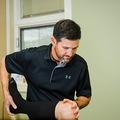
Without the strength of the muscles around it, the lumbar spine can only support about 20 pounds. So obviously the muscles that assist in spine stability must always be working. What happens when the demand on our lumbar spine increases? How do we get the most out of our muscles when performing activities that require core stability especially when there is increased weight involved?
The abdominals, lower back and glute muscles are all involved in core stability. When they are all contracted together, we term this bracing. We want this to be a subconscious effort, but it must be practiced consciously before that will happen. Here is how you practice an abdominal brace.
- Stand or sit up straight and wrap your thumb and index around your waist, just above your pelvis. This should be soft. If it feels hard, your hands should be a little higher.
- Without bending, contract the abdominal and lower back muscles. Picture this:
- Puff out like you are about the get punched in your gut or
- When you cough, you feel tightness in the muscles…hold that or
- Using your abdomen blow out like you are blowing out a candle
- You want to feel a hardening along with an expansion 360 degrees around your spine.
When you inhale, your brace will be become stronger. However, when you practice this, you want to be able to breath normally. For most activities you only need 20-30% of a full contracted brace for adequate stability, depending on the overall strength of the muscles. This is not something we prescribe sets and reps to.




